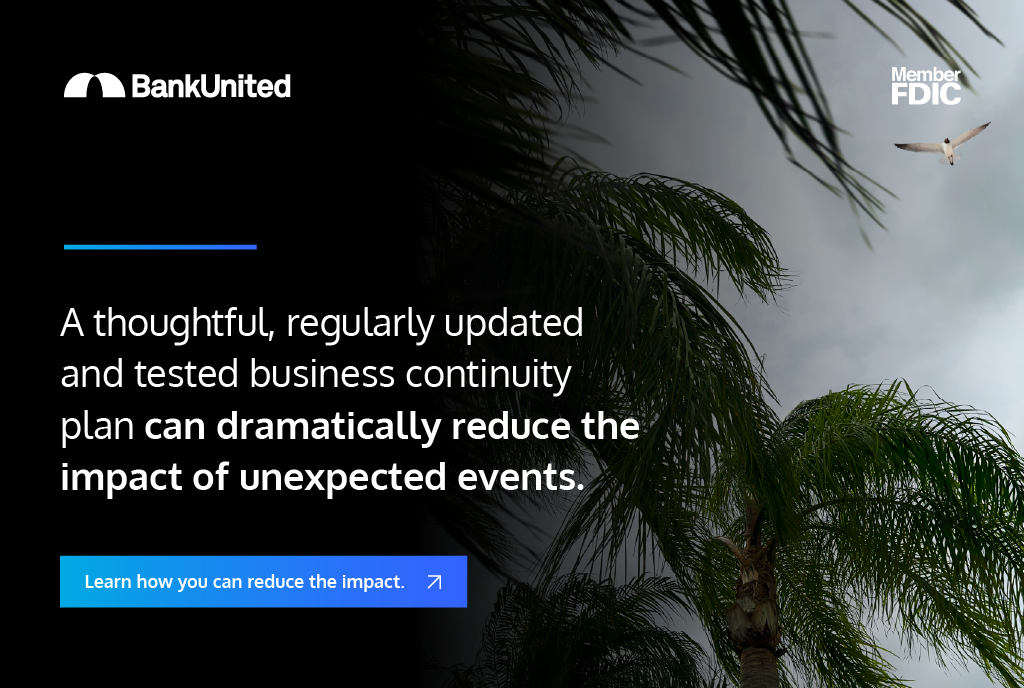With extreme weather increasing in frequency and intensity, small and medium-sized businesses need to be serious about developing a business continuity plan (BCP). It can be a matter of survival: FEMA reports that a quarter of businesses do not reopen after a natural disaster.
A business continuity plan outlines how to keep operations running during disruptions, from hurricanes and floods to cyberattacks and power outages. In other words, it recovers the business no matter what occurs!
Here are four steps you can follow to create an effective business continuity plan.
Step One: Identify Your Risks
One of the main challenges to developing a business continuity plan is resisting the temptation to mitigate every potential risk. The goal is to identify the specific risks that are most likely to disrupt your business, and then evaluate how they could affect operations, employees, and customers.
Step Two: Complete a Business Impact Analysis (BIA)
Every company relies on a core set of essential functions to keep operating, but there should be clarity on what’s truly critical to your company’s success.
A business impact analysis (BIA) helps identify and prioritize key functions, outlining how various disruptions might affect operations, as well as financially, legally, and reputationally. It also assists in setting recovery time objectives (RTOs), which are how quickly you need to restore certain functions.
For example, BankUnited leverages the BIA to ensure the bank appropriately assigns criticality to processes and supporting applications. With that insight, the bank can plan accordingly. FEMA offers a helpful BIA guide to walk businesses through this process.
Step Three: Assess Your Resources
Responding effectively to disruptions requires drawing on company resources, so it’s essential to identify who you need to rely on during a disruption. More importantly, they should be familiar with expectations and have the authority to act quickly.
First, identify essential personnel and clearly identify their roles during an emergency. Then, take stock of the critical resources that have to be protected to keep the business running smoothly. Examples include:
- Customer databases. Ensure contact lists, order histories, and account information are backed up and accessible off-site or in the cloud.
- IT systems and servers. Implement backup power solutions and regular data backups to prevent loss and downtime.
- Manufacturing or operational equipment. Identify key machinery or tools that would most significantly halt production if damaged; plan for protective measures or alternate suppliers.
- Communication tools. Maintain access to email, phone, or internal messaging platforms so teams can remain connected.
- Vendor and supply chain contacts. To minimize delays, keep a secure, updated list of critical vendors and partners.
Knowing which assets are mission-critical shapes your continuity plan.
Step Four: Document Your Plan
Documenting your business continuity plan (BCP) is essential because it details your business strategy and the steps to mitigate impact, and it provides a mechanism to solicit feedback from stakeholders.
While no two business continuity plans will be exactly alike, here are the elements most plans should address:
- Step-by-step procedures. Create a checklist for maintaining critical functions during a disruption.
- Employee roles and responsibilities. Identify key staff members and their roles during the disruption.
- A communication outline. Provide written guidance for how staffers will stay connected during and after a disruption.
- Strategy for preserving critical information. Have a backup system for saving and recovering essential data and information.
- Employee safety protocols. Create plans to ensure the physical safety of employees, including evacuation or rerouting.
- Access to funds. Provide access to backup or emergency funds to ensure the business operates as normally as possible. This should include the ability to continue paying employees and suppliers.
For example, a service provider might activate remote work protocols, reroute client communications through a cloud-based system, and ensure employee safety through pre-arranged evacuation procedures and regular check-ins.
Planning for Success
According to a 2024 Nationwide survey, more than half of mid-market business owners have a disaster recovery plan, and 67% report having a business continuity plan. However, to truly benefit from these efforts, business owners must treat their plans as living documents that are regularly reviewed, updated, and improved. Any plan loses value if it's created and then not adequately distributed as a resource.
To ensure your plan withstands any disruption, be sure to:
- Share the written business continuity plan. Update employees, managers, and other company stakeholders with the current plan and any iterations.
- Actively solicit feedback. Gather feedback from company employees and stakeholders to revise and improve the plan. Take the input seriously, and communicate what feedback is ultimately incorporated into the plan.
- Revisit and revise. Threats to a company continuously change, and so should a business continuity plan. Regularly revisit and revise the plan to ensure that it prepares you for emerging threats.
- Educate. Provide training so staff can efficiently execute the plan and integrate lessons from dry runs into the plan.
No business can prevent every disruption. However, a thoughtful, regularly updated and tested business continuity plan can dramatically reduce the impact of unexpected events. By identifying your greatest risks, prioritizing essential functions, preparing your resources, and documenting your strategy, your business will be equipped to survive a natural disaster or other event and keep your business operating smoothly through any storm.
